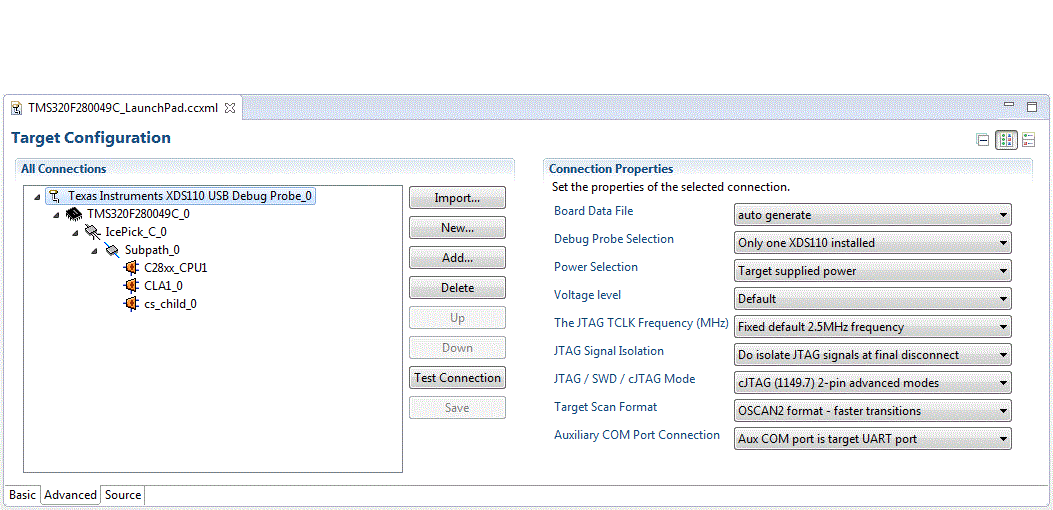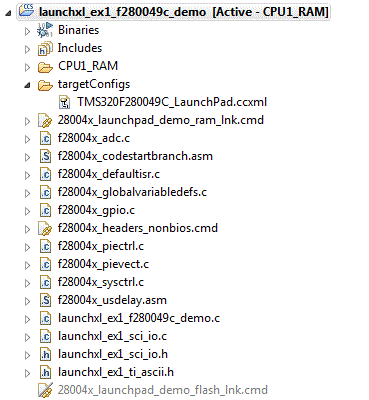SPRUII7B June 2018 – April 2020 TMS320F280040-Q1 , TMS320F280040C-Q1 , TMS320F280041 , TMS320F280041-Q1 , TMS320F280041C , TMS320F280041C-Q1 , TMS320F280045 , TMS320F280048-Q1 , TMS320F280048C-Q1 , TMS320F280049 , TMS320F280049-Q1 , TMS320F280049C , TMS320F280049C-Q1
A.1 Frequently Asked Questions
- Can other programming and debug tools (such as an XDS200 debug probe) be used with the F28004x LaunchPad?
The F28004x LaunchPad utilizes an on-board XDS110 debug probe in a 2-pin cJTAG configuration. cJTAG only uses the TMS and TCK pins of the debug probe. TDI and TDO are present on the BoosterPack connectors and can be connected to a debug probe through jumper wires, if necessary.
- What versions of Code Composer Studio can be used to develop software for the F28004x LaunchPad?
The on-board XDS110 debug probe is compatible with Code Composer Studio development environment version 6.1.0 and later.
- Why can't I connect to the LaunchPad in Code Composer Studio?
- Are shunts present on J101 for TCK and TMS?
- Is the XDS110 and the F280049C MCU powered? Is LED1 illuminated?
If JP1, JP2, and JP3 are disconnected, the power provided through the USB is isolated from the rest of the board. Ensure that 3.3 V is supplied to any of the available connectors on the target side of the isolation.
- Is the micro-USB connected to the PCB and is the USB region receiving power? Is LED0 illuminated?
The USB region must be powered with the 5 V from the USB cable. LED0 will illuminate when the 5V is stepped down to 3.3 V for the USB isolation chip to operate and pass the signals across the isolation barrier.
- Ensure that the target configuration is set up to use cJTAG in 2-pin advanced mode.
Open the Target Configuration file (.ccxml) in Code Composer Studio. Click on the Advanced tab and select cJTAG (1149.7) 2-pin advanced modes from the drop-down labeled JTAG/SWD/cJTAG Mode. Leave the Target Scan Format as OSCAN2 format.
Alternately, a working Target configuration file is included in the launcxl_ex1_f280049c_demo project "TMS320F280049C_LaunchPad.ccxml". You can use this without modifications.
 Figure 13. Target Configuration Advanced Options
Figure 13. Target Configuration Advanced Options  Figure 14. Target Configuration included in the demo project
Figure 14. Target Configuration included in the demo project
- Is XDS110 firmware version 2.3.0.16 installed? This is contained in Emulation Package 8.0.903.4. If so, this version of the XDS110 firmware breaks the cJTAG connection. To confirm which XDS110 firmware is used, and update the firmware, follow these steps:
- Verify current XDS110 firmware version by connecting the LaunchPad to the PC through the USB cable and executing "xdsdfu -e" in the command prompt.
If the current version is not v2.3.0.16, move on to other methods to resolve the connection issues. Else, continue this procedure
- Install the Emulation Package 8.1.0.00005 which contains the previous XDS110 v2.3.0.17 firmware using the instructions found HERE. Alternatively, you can install the older Emulation Package 8.0.803.0 which contains XDS firmware version 2.3.0.15.
- In a command prompt, navigate to the emulation driver within your CCS installation and execute the following commands. e.g. C:\ti\ccsv8\ccs_base\common\uscif\xds110\
- xdsdfu -m
- xdsdfu -f firmware.bin -r
- Power cycle the LaunchPad.
- Verify new XDS110 firmware version by again executing "xdsdfu -e" in the command prompt. Ensure that v2.3.0.16 is not installed.
NOTE
Prior to XDS110 version 2.3.0.14, the cJTAG connection with the F28004x MCU was not working. Ensure that version 2.3.0.14 or newer, with the exception of firmware version 2.3.0.16, is running on the XDS110. Any older versions of the XDS110 firmware will not operate as expected.
- Verify current XDS110 firmware version by connecting the LaunchPad to the PC through the USB cable and executing "xdsdfu -e" in the command prompt.
- Why is the serial connection not working?
- Are shunts present on J101 for TXD and RXD?
- Are you using the correct COM port?
Right click on My Computer and select Properties. Navigate to the Hardware tab in the dialog box and open the device manager. Scroll to Ports (COM & LPT) and expand this entry. Is XDS110 Class Application/User UART listed? If so, read the COM number to the right of the entry; this is the COM number you should be using.
- Are you using the correct baud rate?
Most, if not all, of the examples are configured for a baud rate of 115200 when the CPU is running at 100 MHz. If you have changed the PLL settings or developed your own code you may have to recalculate the baud rate for your specific application. For information on how to do this, see theTMS320F28004x Piccolo™ Microcontrollers Technical Reference Manual.
- Does the UART channel wired to the debug probe match the UART channel configured in your software?
The F28004x LaunchPad provides an option for one of two possible UART channels to be routed to the debug probe through J101. Ensure that S3, S4, S6, and S8 are configured to the appropriate UART channel for your application. ,For more information about the Alternate Routing possibilities, see Section 2.3.